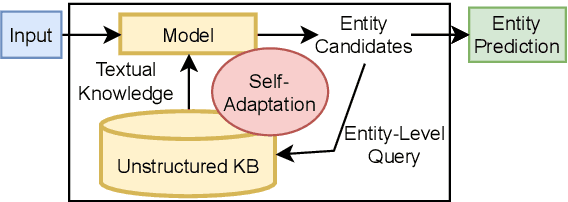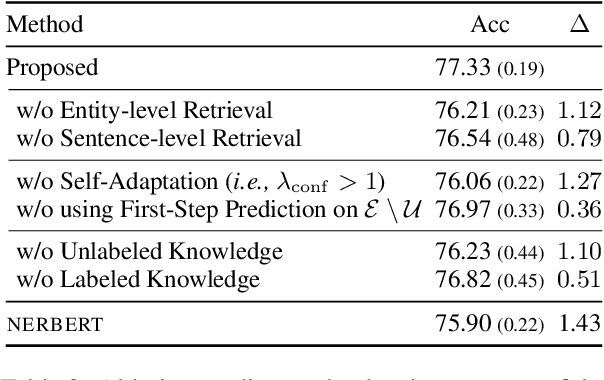Kyosuke Nishida
Let's Put Ourselves in Sally's Shoes: Shoes-of-Others Prefixing Improves Theory of Mind in Large Language Models
Jun 06, 2025Abstract:Recent studies have shown that Theory of Mind (ToM) in large language models (LLMs) has not reached human-level performance yet. Since fine-tuning LLMs on ToM datasets often degrades their generalization, several inference-time methods have been proposed to enhance ToM in LLMs. However, existing inference-time methods for ToM are specialized for inferring beliefs from contexts involving changes in the world state. In this study, we present a new inference-time method for ToM, Shoes-of-Others (SoO) prefixing, which makes fewer assumptions about contexts and is applicable to broader scenarios. SoO prefixing simply specifies the beginning of LLM outputs with ``Let's put ourselves in A's shoes.'', where A denotes the target character's name. We evaluate SoO prefixing on two benchmarks that assess ToM in conversational and narrative contexts without changes in the world state and find that it consistently improves ToM across five categories of mental states. Our analysis suggests that SoO prefixing elicits faithful thoughts, thereby improving the ToM performance.
VDocRAG: Retrieval-Augmented Generation over Visually-Rich Documents
Apr 14, 2025Abstract:We aim to develop a retrieval-augmented generation (RAG) framework that answers questions over a corpus of visually-rich documents presented in mixed modalities (e.g., charts, tables) and diverse formats (e.g., PDF, PPTX). In this paper, we introduce a new RAG framework, VDocRAG, which can directly understand varied documents and modalities in a unified image format to prevent missing information that occurs by parsing documents to obtain text. To improve the performance, we propose novel self-supervised pre-training tasks that adapt large vision-language models for retrieval by compressing visual information into dense token representations while aligning them with textual content in documents. Furthermore, we introduce OpenDocVQA, the first unified collection of open-domain document visual question answering datasets, encompassing diverse document types and formats. OpenDocVQA provides a comprehensive resource for training and evaluating retrieval and question answering models on visually-rich documents in an open-domain setting. Experiments show that VDocRAG substantially outperforms conventional text-based RAG and has strong generalization capability, highlighting the potential of an effective RAG paradigm for real-world documents.
Portable Reward Tuning: Towards Reusable Fine-Tuning across Different Pretrained Models
Feb 18, 2025Abstract:While foundation models have been exploited for various expert tasks through fine-tuning, any foundation model will become outdated due to its old knowledge or limited capability. Thus the underlying foundation model should be eventually replaced by new ones, which leads to repeated cost of fine-tuning these new models. Existing work addresses this problem by inference-time tuning, i.e., modifying the output probabilities from the new foundation model with the outputs from the old foundation model and its fine-tuned model, which involves an additional overhead in inference by the latter two models. In this paper, we propose a new fine-tuning principle, Portable Reward Tuning (PRT), that reduces the inference overhead by its nature, based on the reformulation of fine-tuning as the reward maximization. Specifically, instead of fine-tuning parameters of the foundation models, PRT trains the reward model explicitly through the same loss function as in fine-tuning. During inference, the reward model can be used with any foundation model (with the same set of vocabularies or labels) through the formulation of reward maximization. Experimental results, covering both vision and language models, demonstrate that the PRT-trained model can achieve comparable accuracy to the existing work of inference-time tuning, with less inference cost.
Wavelet-based Positional Representation for Long Context
Feb 04, 2025Abstract:In the realm of large-scale language models, a significant challenge arises when extrapolating sequences beyond the maximum allowable length. This is because the model's position embedding mechanisms are limited to positions encountered during training, thus preventing effective representation of positions in longer sequences. We analyzed conventional position encoding methods for long contexts and found the following characteristics. (1) When the representation dimension is regarded as the time axis, Rotary Position Embedding (RoPE) can be interpreted as a restricted wavelet transform using Haar-like wavelets. However, because it uses only a fixed scale parameter, it does not fully exploit the advantages of wavelet transforms, which capture the fine movements of non-stationary signals using multiple scales (window sizes). This limitation could explain why RoPE performs poorly in extrapolation. (2) Previous research as well as our own analysis indicates that Attention with Linear Biases (ALiBi) functions similarly to windowed attention, using windows of varying sizes. However, it has limitations in capturing deep dependencies because it restricts the receptive field of the model. From these insights, we propose a new position representation method that captures multiple scales (i.e., window sizes) by leveraging wavelet transforms without limiting the model's attention field. Experimental results show that this new method improves the performance of the model in both short and long contexts. In particular, our method allows extrapolation of position information without limiting the model's attention field.
ToMATO: Verbalizing the Mental States of Role-Playing LLMs for Benchmarking Theory of Mind
Jan 15, 2025Abstract:Existing Theory of Mind (ToM) benchmarks diverge from real-world scenarios in three aspects: 1) they assess a limited range of mental states such as beliefs, 2) false beliefs are not comprehensively explored, and 3) the diverse personality traits of characters are overlooked. To address these challenges, we introduce ToMATO, a new ToM benchmark formulated as multiple-choice QA over conversations. ToMATO is generated via LLM-LLM conversations featuring information asymmetry. By employing a prompting method that requires role-playing LLMs to verbalize their thoughts before each utterance, we capture both first- and second-order mental states across five categories: belief, intention, desire, emotion, and knowledge. These verbalized thoughts serve as answers to questions designed to assess the mental states of characters within conversations. Furthermore, the information asymmetry introduced by hiding thoughts from others induces the generation of false beliefs about various mental states. Assigning distinct personality traits to LLMs further diversifies both utterances and thoughts. ToMATO consists of 5.4k questions, 753 conversations, and 15 personality trait patterns. Our analysis shows that this dataset construction approach frequently generates false beliefs due to the information asymmetry between role-playing LLMs, and effectively reflects diverse personalities. We evaluate nine LLMs on ToMATO and find that even GPT-4o mini lags behind human performance, especially in understanding false beliefs, and lacks robustness to various personality traits.
Initialization of Large Language Models via Reparameterization to Mitigate Loss Spikes
Oct 07, 2024Abstract:Loss spikes, a phenomenon in which the loss value diverges suddenly, is a fundamental issue in the pre-training of large language models. This paper supposes that the non-uniformity of the norm of the parameters is one of the causes of loss spikes. Here, in training of neural networks, the scale of the gradients is required to be kept constant throughout the layers to avoid the vanishing and exploding gradients problem. However, to meet these requirements in the Transformer model, the norm of the model parameters must be non-uniform, and thus, parameters whose norm is smaller are more sensitive to the parameter update. To address this issue, we propose a novel technique, weight scaling as reparameterization (WeSaR). WeSaR introduces a gate parameter per parameter matrix and adjusts it to the value satisfying the requirements. Because of the gate parameter, WeSaR sets the norm of the original parameters uniformly, which results in stable training. Experimental results with the Transformer decoders consisting of 130 million, 1.3 billion, and 13 billion parameters showed that WeSaR stabilizes and accelerates training and that it outperformed compared methods including popular initialization methods.
InstructDoc: A Dataset for Zero-Shot Generalization of Visual Document Understanding with Instructions
Jan 24, 2024Abstract:We study the problem of completing various visual document understanding (VDU) tasks, e.g., question answering and information extraction, on real-world documents through human-written instructions. To this end, we propose InstructDoc, the first large-scale collection of 30 publicly available VDU datasets, each with diverse instructions in a unified format, which covers a wide range of 12 tasks and includes open document types/formats. Furthermore, to enhance the generalization performance on VDU tasks, we design a new instruction-based document reading and understanding model, InstructDr, that connects document images, image encoders, and large language models (LLMs) through a trainable bridging module. Experiments demonstrate that InstructDr can effectively adapt to new VDU datasets, tasks, and domains via given instructions and outperforms existing multimodal LLMs and ChatGPT without specific training.
Robust Text-driven Image Editing Method that Adaptively Explores Directions in Latent Spaces of StyleGAN and CLIP
Apr 03, 2023Abstract:Automatic image editing has great demands because of its numerous applications, and the use of natural language instructions is essential to achieving flexible and intuitive editing as the user imagines. A pioneering work in text-driven image editing, StyleCLIP, finds an edit direction in the CLIP space and then edits the image by mapping the direction to the StyleGAN space. At the same time, it is difficult to tune appropriate inputs other than the original image and text instructions for image editing. In this study, we propose a method to construct the edit direction adaptively in the StyleGAN and CLIP spaces with SVM. Our model represents the edit direction as a normal vector in the CLIP space obtained by training a SVM to classify positive and negative images. The images are retrieved from a large-scale image corpus, originally used for pre-training StyleGAN, according to the CLIP similarity between the images and the text instruction. We confirmed that our model performed as well as the StyleCLIP baseline, whereas it allows simple inputs without increasing the computational time.
SlideVQA: A Dataset for Document Visual Question Answering on Multiple Images
Jan 12, 2023Abstract:Visual question answering on document images that contain textual, visual, and layout information, called document VQA, has received much attention recently. Although many datasets have been proposed for developing document VQA systems, most of the existing datasets focus on understanding the content relationships within a single image and not across multiple images. In this study, we propose a new multi-image document VQA dataset, SlideVQA, containing 2.6k+ slide decks composed of 52k+ slide images and 14.5k questions about a slide deck. SlideVQA requires complex reasoning, including single-hop, multi-hop, and numerical reasoning, and also provides annotated arithmetic expressions of numerical answers for enhancing the ability of numerical reasoning. Moreover, we developed a new end-to-end document VQA model that treats evidence selection and question answering in a unified sequence-to-sequence format. Experiments on SlideVQA show that our model outperformed existing state-of-the-art QA models, but that it still has a large gap behind human performance. We believe that our dataset will facilitate research on document VQA.
Self-Adaptive Named Entity Recognition by Retrieving Unstructured Knowledge
Oct 14, 2022



Abstract:Although named entity recognition (NER) helps us to extract various domain-specific entities from text (e.g., artists in the music domain), it is costly to create a large amount of training data or a structured knowledge base to perform accurate NER in the target domain. Here, we propose self-adaptive NER, where the model retrieves the external knowledge from unstructured text to learn the usage of entities that has not been learned well. To retrieve useful knowledge for NER, we design an effective two-stage model that retrieves unstructured knowledge using uncertain entities as queries. Our model first predicts the entities in the input and then finds the entities of which the prediction is not confident. Then, our model retrieves knowledge by using these uncertain entities as queries and concatenates the retrieved text to the original input to revise the prediction. Experiments on CrossNER datasets demonstrated that our model outperforms the strong NERBERT baseline by 2.45 points on average.
 Add to Chrome
Add to Chrome Add to Firefox
Add to Firefox Add to Edge
Add to Edge